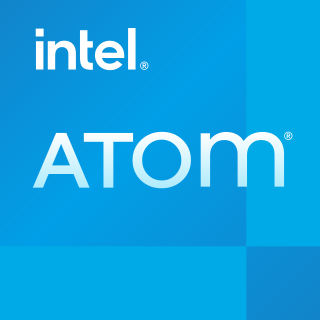
VIA Technologies, Inc. is a Taiwanese manufacturer of integrated circuits, mainly motherboard chipsets, CPUs, and memory. It was the world's largest independent manufacturer of motherboard chipsets. As a fabless semiconductor company, VIA conducts research and development of its chipsets in-house, then subcontracts the actual (silicon) manufacturing to third-party merchant foundries such as TSMC.
Open64 is a free, open-source, optimizing compiler for the Itanium and x86-64 microprocessor architectures. It derives from the SGI compilers for the MIPS R10000 processor, called MIPSPro. It was initially released in 2000 as GNU GPL software under the name Pro64. The following year, University of Delaware adopted the project and renamed the compiler to Open64. It now mostly serves as a research platform for compiler and computer architecture research groups. Open64 supports Fortran 77/95 and C/C++, as well as the shared memory programming model OpenMP. It can conduct high-quality interprocedural analysis, data-flow analysis, data dependence analysis, and array region analysis. Development has ceased, although other projects can use the project's source.

A multi-core processor is a microprocessor on a single integrated circuit with two or more separate processing units, called cores, each of which reads and executes program instructions. The instructions are ordinary CPU instructions but the single processor can run instructions on separate cores at the same time, increasing overall speed for programs that support multithreading or other parallel computing techniques. Manufacturers typically integrate the cores onto a single integrated circuit die or onto multiple dies in a single chip package. The microprocessors currently used in almost all personal computers are multi-core.

Larrabee is the codename for a cancelled GPGPU chip that Intel was developing separately from its current line of integrated graphics accelerators. It is named after either Mount Larrabee or Larrabee State Park in Whatcom County, Washington, near the town of Bellingham. The chip was to be released in 2010 as the core of a consumer 3D graphics card, but these plans were cancelled due to delays and disappointing early performance figures. The project to produce a GPU retail product directly from the Larrabee research project was terminated in May 2010 and its technology was passed on to the Xeon Phi. The Intel MIC multiprocessor architecture announced in 2010 inherited many design elements from the Larrabee project, but does not function as a graphics processing unit; the product is intended as a co-processor for high performance computing.

TILE64 is a VLIW ISA multicore processor manufactured by Tilera. It consists of a mesh network of 64 "tiles", where each tile houses a general purpose processor, cache, and a non-blocking router, which the tile uses to communicate with the other tiles on the processor.

Intel Atom is a line of IA-32 and x86-64 instruction set ultra-low-voltage processors by Intel Corporation designed to reduce electric consumption and power dissipation in comparison with ordinary processors of the Intel Core series. Atom is mainly used in netbooks, nettops, embedded applications ranging from health care to advanced robotics, mobile Internet devices (MIDs) and phones. The line was originally designed in 45 nm complementary metal–oxide–semiconductor (CMOS) technology and subsequent models, codenamed Cedar, used a 32 nm process.

Anant Agarwal is an Indian computer architecture researcher. He is a professor of Electrical Engineering and Computer Science at the Massachusetts Institute of Technology (MIT), where he led the development of Alewife, an early cache coherent multiprocessor, and also has served as director of the MIT Computer Science and Artificial Intelligence Laboratory. He is the founder and CTO of Tilera, a fabless semiconductor company focusing on scalable multicore embedded processor design. He also serves as the CEO of edX, a joint partnership between MIT and Harvard University that offers free online learning.

A mini PC is a small-sized, inexpensive, low-power, legacy-free desktop computer designed for basic tasks such as web browsing, accessing web-based applications, document processing, and audio/video playback.
Manycore processors are special kinds of multi-core processors designed for a high degree of parallel processing, containing numerous simpler, independent processor cores. Manycore processors are used extensively in embedded computers and high-performance computing.
TILE-Gx was a VLIW ISA multicore processor family designed by Tilera. It consisted of a mesh network that was expected to scale up to 100 cores, but only 72-core variants actually shipped.

TILEPro64 is a VLIW ISA multicore processor manufactured by Tilera. It consists of a cache-coherent mesh network of 64 "tiles", where each tile houses a general purpose processor, cache, and a non-blocking router, which the tile uses to communicate with the other tiles on the processor.
Tile processors for computer hardware, are multicore or manycore chips that contain one-dimensional, or more commonly, two-dimensional arrays of identical tiles. Each tile comprises a compute unit, caches and a switch. Tiles can be viewed as adding a switch to each core, where a core comprises a compute unit and caches.

Mellanox Technologies Ltd. was an Israeli-American multinational supplier of computer networking products based on InfiniBand and Ethernet technology. Mellanox offered adapters, switches, software, cables and silicon for markets including high-performance computing, data centers, cloud computing, computer data storage and financial services.
The Data Plane Development Kit (DPDK) is an open source software project managed by the Linux Foundation. It provides a set of data plane libraries and network interface controller polling-mode drivers for offloading TCP packet processing from the operating system kernel to processes running in user space. This offloading achieves higher computing efficiency and higher packet throughput than is possible using the interrupt-driven processing provided in the kernel.
The OpenPOWER Foundation is a collaboration around Power ISA-based products initiated by IBM and announced as the "OpenPOWER Consortium" on August 6, 2013. IBM's focus is to open up technology surrounding their Power Architecture offerings, such as processor specifications, firmware, and software with a liberal license, and will be using a collaborative development model with their partners.
Heterogeneous computing refers to systems that use more than one kind of processor or core. These systems gain performance or energy efficiency not just by adding the same type of processors, but by adding dissimilar coprocessors, usually incorporating specialized processing capabilities to handle particular tasks.
A vision processing unit (VPU) is an emerging class of microprocessor; it is a specific type of AI accelerator, designed to accelerate machine vision tasks.

Zhaoxin is a fabless semiconductor company, created in 2013 as a joint venture between VIA Technologies and the Shanghai Municipal Government. The company manufactures x86-compatible desktop and laptop CPUs. The term Zhàoxīn means million core. The processors are created mainly for the Chinese market: the venture is an attempt to reduce the Chinese dependence on foreign technology.








